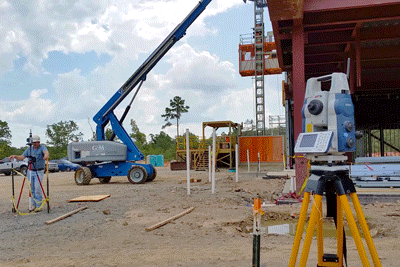| Contributors: | Michael Parker, EVP of Preconstruction |
| Hank Merkel, BIM Specialist | |
| Mike Armstrong, Project Manager |
You’ve probably seen construction surveying crews at work—whether driving along a highway or past a building project in town—but do you know what that “tripod thing” they’re always looking into is called? It’s called (wait for it…) a total station. For the past two decades or so, the total station has been the go-to tool for laying out construction projects. Layout is the process of carefully measuring and staking out the main building features on the ground so the construction crew builds everything in the right place. It is an ongoing process that starts with marking where all building foundations will go, continues with laying out interior and exterior walls, and ends with verifying final locations once features are installed. This process is critical to ensuring that the building or structure is built in the proper location, taking into account important factors like property boundaries, local regulations, and land reserved for use by municipalities and utility companies. After all, it’s pretty difficult to move a building once it’s built, so if something goes wrong during the layout process and the final building crosses one of those boundaries, it could lead to major problems, including legal action!
Recent advancements in technology have now given us the Robotic Total Station, an improvement on the older total stations. In addition to measuring on the horizontal planes (north-to-south and east-to-west) like a regular total station, the Robotic Total Station (RTS) is also capable of measuring on the vertical plane (elevation). Plus, it uses laser beams to accurately record distance measurements.

While enhanced accuracy is reason enough to love the Robotic Total Station, the advantages don’t stop there. Using an old total station, you need two people to perform layout: one to operate the total station and another to hold a prism reflector and locate the various points to be marked. With the Robotic Total Station, you still need someone to walk to the points and hold the prism, but the RTS automatically rotates to follow the prism and even tells the person exactly where to go to layout the points. Think of it as “you’re getting warmer” with laser precision. This means you only need one person instead of two to perform the layout.
At Nabholz, we have a Research & Development Grant Program in place to encourage our team to explore, develop, and implement new technologies in our field. When the preconstruction team in our South Central Operation learned about the Robotic Total Station, they wanted to test it out to see how easy it is to use, what kind of learning curve it has compared to a standard total station, and whether it really is as accurate and efficient as the developers claim. This was a perfect candidate for a Nabholz R&D grant, so the funds were awarded and the trial was conducted back in early 2013.
Our team chose an expansion project at Johnson Regional Medical Center in Clarksville, Arkansas as the test project. The design of the patient rooms called for many of the walls to be built at an angle rather than square with the building, so BIM Specialist Hank Merkel loaded layout points from the CAD drawings directly into the RTS. This is another significant advantage the RTS has over a traditional total station as it saves time and eliminates the potential for human error caused by manual data conversion and entry. When the team used the RTS to check the wall layout, they found that our drywall subcontractor did an excellent job—everything was verified to be within the 1/8” threshold.
The grant project proved that the Robotic Total Station could boost both accuracy and efficiency of the layout process with a short learning curve for our team. Due to this success, Nabholz has since purchased RTS equipment and is currently using it on projects. At CARTI in Little Rock, for example, we have been able to perform layout, check subcontractor layout, and spot potential conflicts. With BIM being utilized heavily on this particular project, we’ve been able to load points directly from the BIM models. Project Manager Mike Armstrong, who is currently working at CARTI says that “the Robotic Total Station is worth its weight in gold!”
RTS technology is a true quality control tool that increases the efficiency and accuracy of our work. It saves both time and money by preventing rework in the field, which means better projects and potential savings for building Owners.
Want to know more about how we’re using the Robotic Total Station on Nabholz projects? Get in touch with Michael Parker at michael.parker@nabholz.com.


